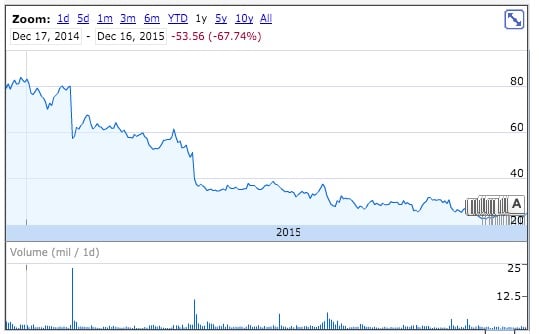We’re reading a report from Kiplinger entitled, “Five Stocks to Sell Now”. One of them is Stratasys! We’re not so sure this is good advice.
Here’s what they say about Stratasys:
For Stratasys (SSYS, $26), a maker of 3D printers, the challenge these days is stiffer competition. Businesses and consumers are buying 3D printers to churn out everything from dental implants to homemade guns. But rivals have muscled into the business, and demand for the hardware and related services hasn’t climbed as much as expected. UBS analyst Steven Milunovich says that with the stock at 31 times his 2016 profit estimate, Stratasys’s price-earnings ratio is becoming “more realistic.” But “we don’t yet have confidence in the earnings,” adds Milunovich, who rates the stock a “sell” and has a 12-month price target of $18.
At first glance, this might appear the thing to do, as Stratasys’ stock price has plummeted precipitously in the past year, as you can see in this chart:
Our understanding is that Stratasys, along with other industrial 3D printer manufacturers, continues to grow. What’s happened is that there was a burst of public awareness of 3D printing in the last couple of years, and a resulting rush to buy stocks in the futuristic technology. Complicating this rush was the fact that there are very few 3D printing stocks publicly traded, Stratasys being one of them.
Thus its stock price rose to very high levels, probably higher than they should have been. But then again, the market speaks. Eventually, the market learned more about the technology and realized the price was too high. The price dropped.
Meanwhile, Stratasys the company continues to operate, market new products and has a hugely successful set of distribution channels, in spite of market effects.
The company continues to “turn on” more clients to the advantages of 3D printing in specific industries, as well as retooling their MakerBot operation, so we believe it is not a good time to sell your Stratasys stock.
Don’t they say, “Buy Low, Sell High”? Today, the price may be low, and is it really a good idea to Buy High and Sell Low?
Via Kiplinger


